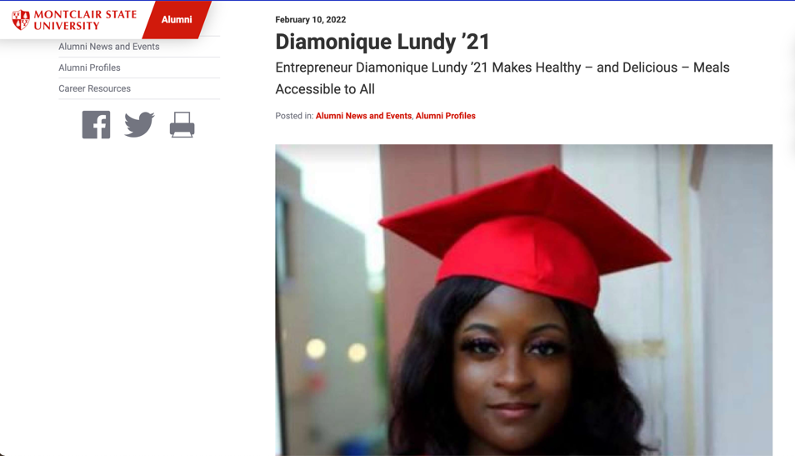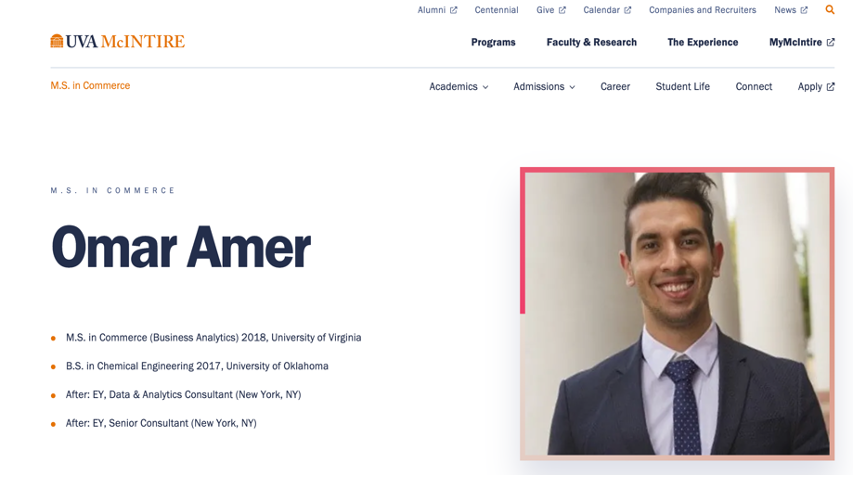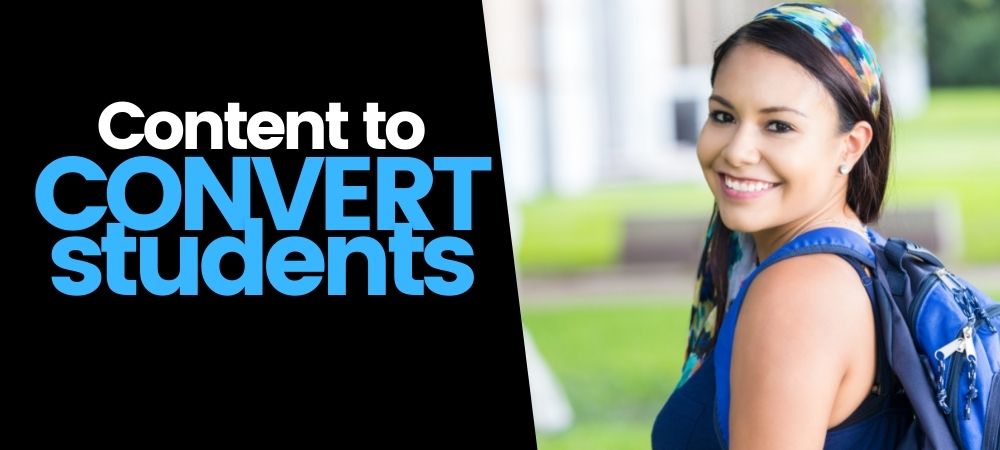“The most successful admissions professionals understand they are not just recruiters but also expert marketers.” – Benjamin Boivin, Keystone Education Group
Higher ed recruitment and admissions teams began transforming into marketing task forces decades ago. It’s now common practice for enrollment teams to reframe their efforts in terms of customer service, similar to the playbooks for other profit-based industries.
It may sound simple in theory, but it’s not. A customer-focused marketing strategy requires a working knowledge of the sales funnel. Sales funnels differ from team to team, and market to market, but tend to include three basic stages:
1. Top of funnel (TOFU)
A prospect first learns about a brand.
2. Middle of funnel (MOFU)
A brand-aware prospect engages with you.
3. Bottom of funnel (BOFU)
The prospect decides whether or not to purchase—or, for the purposes of higher ed, whether or not to apply and/or accept enrollment.
Though all three are crucial to attracting and converting prospects for higher ed admissions, creating effective BOFU content is vital. What’s more, for educational institutions, BOFU content might be provided to a wide audience—from potential applicants to incoming first-year students who’ve made a deposit.
The content you offer for the bottom of the funnel can be a huge contributing factor to two of your “make-or-break” metrics: yield and melt.
In this article, we’ll examine three top BOFU tactics for higher ed admissions teams, along with some examples of useful BOFU content to deploy at specific points in the student journey.
1. Divide and conquer with personalization
Good marketers rely on data. Great marketers rely on data to build useful personas to create targeted messaging.
No doubt, your admissions team collects a ton of information surrounding the demographics of its prospective students, website and email engagement, recruiting event attendance, and more.
If you’re utilizing the data appropriately, you know where each prospect stands in the enrollment pipeline at any given point in time. You should also understand the content you develop must speak directly to each prospect and anticipate their individual needs, questions, and concerns.
Personalized content has a proven track record and can remove the “feeling like a number” syndrome that tends to alienate prospects across nearly every industry.
Student-facing content should speak directly to each prospect and focus on their needs.
It’s helpful to begin segmenting your prospective student pool into distinct groups (or personas), each detailing how far along the segment is in the sales funnel while homing in on other key markers such as age, location, and financial aid status, etc.
Higher ed prospects who’ve made it to the BOFU stage can be broken down even further into even more specialized profiles, including:
Intended students—prospects who’ve expressed legitimate interest in applying to your institution
Content messaging for this group should be centered on differentiating your school from its competitors and highlighting your unique selling points. For intended students, you’ll want to create:
- Case studies in the form of student/graduate success stories
- Personalized outreach emails
- Open houses/simulated classes designed specifically for recruits
Applicants—students who’ve filled out the requisite forms and hit “send” on their applications
This group has made a decision to invest time and money into landing a spot at your institution. Of course, this doesn’t mean they haven’t applied elsewhere.
Students at this stage need to be kept “warm” with increased person-to-person contacts from your team such as:
- Financial aid counseling
- Relationship-building events such as webinars or informal video meetings
- Social media outreach initiated by existing students, professors, or staff
Accepted applicants—students who’ve been accepted to your institution and/or begun the enrollment process in some capacity.
Of course, accepted applicants are still prospects, so your admissions team must nurture them and hold their attention until they sign on the dotted line. Content for accepted applicants should be even more granular in its approach, ramping up interpersonal outreach efforts and providing detailed, informative answers to their questions through projects such as:
- Digital course catalogs (complete with images, video clips, and registration forms)
- Social media meetups that allow accepted applicants to chat with one another or introduce themselves to existing students
- Online orientations geared toward generating enthusiasm for campus traditions, annual events, dorm life, team sports, etc.
Note that if you fail to cultivate genuine connections with accepted applicants, it can result in lower yield percentages and higher melt rates. BOFU content for these audiences should be expertly curated and distributed with care.
2. Activate and advocate
For many industries, BOFU content is a space for tasteful self-promotion where content is meant to advocate for a product by stressing its value. Ideally, these types of content assets:
- Follow a “show/don’t tell” model that lets customers imagine themselves actively enjoying the benefits of a product/service
- Highlight past successes in an educational way (e.g., through interviews with satisfied clients, in-depth customer testimonials, or prosperous consumer case studies)
- Adopt a less impartial tone and tip the scales in favor of the purchase.
All this applies to your bottom of the funnel content, especially for content intended to seal the deal with students who’ve been accepted but have yet to enroll. Your team should aim to increase yield and lower melt by implementing BOFU strategies that (1) activate the higher ed experience for accepted students, and (2) advocate for your institution.
Fight low yield and high melt with content that activates student participation and advocates for your institution.
BOFU content that activates participation encourages accepted applicants to envision what college life will be like, shifting their mindset from “passive prospect” to “active student.” These assets position student life as an immediate reality, rather than an abstract concept.
Examples:
- Nurture-minded content such as personalized email campaigns that walk the student through class registration, roommate selection, orientation week schedules, etc.
- Behind-the-scenes videos featuring candid interviews with current first-year students, alumni, or instructors. (Video clips from inside the classroom can go a long way toward “activating” the daily college experience.)
- Virtual/in-person sleepovers in which accepted applicants can shadow students from class to class during the day and test out the dorms at night.
BOFU content that advocates your college showcases the advantages it offers. Its goal is to make your school stand out by accentuating its most attractive features.
Examples:
- Video/social media posts featuring professors and students who play an active role in their college community (i.e., campus “influencer” feeds).
- Interactive virtual tours allowing students to explore campus architecture, statues, monuments, artwork, natural sanctuaries, etc.
- Digital infographics covering lesser-known degree programs, niche student societies, or hidden-gem classes.

3. Set the stage for the next steps
As you craft your BOFU content for students, remember to pave the way for what comes next. Include transitional messaging and material that helps pass the baton to other departments or services designed to support the student lifecycle (such as student/academic affairs, residential life, financial aid, registrar, meal programming, and so on).
Be sure to include transitional messaging and material that passes the baton to other departments.
Use your outreach channels to build a bridge from pre- to post-enrollment life by:
- Facilitating introductions between deposited students and financial aid representatives, RAs, library assistants, registrar officials, etc., to help ease enrollees into their first semester
- Providing print and digital copies of all necessary enrollment forms and following up at regular intervals to offer reminders/additional guidance
- Organizing a first-day dry run (in which students can practice navigating from one class to the next)
It’s also worthwhile to create content around life after graduation.
As applicants become bonafide students, they’ll likely need a little extra motivation, along with some added assurance they’ve made the right decision. A reaffirmation of your commitment to their continued success can help allay any fears.
Boost first-year confidence with assets such as:
- Video/digital profiles of select alumni who’ve gone on to achieve success in their field
These videos should underscore the parallels between the skills alums acquired in school and the skills they’ve been able to apply to their careers. - Podcasts featuring alumni interviews
These can keep the endgame of graduation fresh in students’ minds. It will also help to humanize alums, making it easier for students to picture themselves in their shoes. - Print/digital material that can be used for professional networking
Examples include including alumni directories organized by industry, resources for post-graduation housing, banking, or legal/business counselingm and pointers on interview preparation.


Whichever tools you use to usher prospects from candidacy to starts, remember:
Like all expert marketers, your task will be to monitor and measure engagement across the entire funnel (from top to bottom) and refine, reassess, and reconfigure as you go.
The new age of consumer-centric educational marketing puts much of the power in your audience’s hands, but your team still retains enough influence to rein-in great recruits.
Be sure an adaptable program for comprehensive BOFU content is an integral part of your student recruitment strategy.









